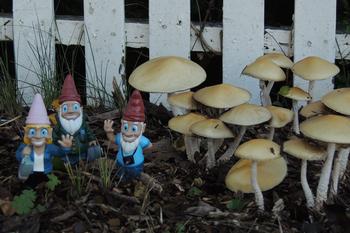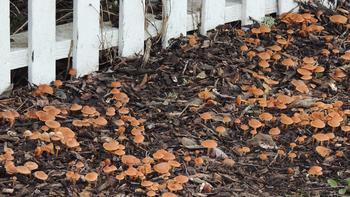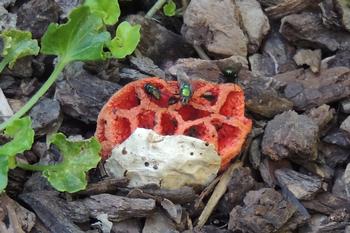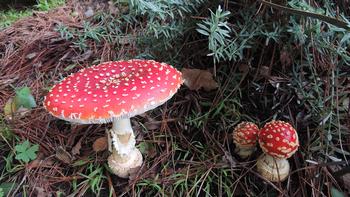Have you ever thought about fungi?
-
Diane Lynch
-
I find mushrooms to be some of the most interesting life to be found. They come in infinite shapes, colors, and sizes. Some are edible and delicious. Others can be fatal if consumed. Some attract flies to spread themselves around. Some are even phosphorescent. And their root systems are amazing and can be enormous.
 The gnomes were excited to go see the mushrooms in the neighborhood. Photo: Diane Lynch
The gnomes were excited to go see the mushrooms in the neighborhood. Photo: Diane LynchSince many of us were in biology classes, much has changed in the way living organisms are classified. Mushrooms have their own kingdom, Funga. They don't photosynthesize to make their own food. Interestingly, there are myriad ways that mushrooms can be shown to be phylogenetically closer to animals than plants, from cell structure to metabolic pathways.
The part we see above ground is called the fruiting body, cap, or flower, and it produces reproductive spores, which are microscopic and can only be seen in a spore print, which you can make by putting a cap (cutting the stem off) on a piece of white paper. Then, cover it overnight with a glass or plastic container so the spores stay in place.
The underground parts of the organism aren't called roots but rather hyphae (singular hypha) that congregate into a sometimes huge mycelium, a tangle of white and brown threadlike structures that constitute a root system from which the fruiting bodies emerge when conditions are right. The mycelium uses enzymes to basically feed itself and allow it to fruit. They are important recyclers as they break down nutrients in dead wood and other organic matter. This outcropping of LBJs (little brown jobs) has a sizable mycelium underground. Photo: Diane Lynch
This outcropping of LBJs (little brown jobs) has a sizable mycelium underground. Photo: Diane LynchThe most famous huge mycelium is in Oregon. Known as Humongous Fungus, it's a honey fungus (Armillaria ostoyae) that lives on dead or dying trees. It's about 2400 acres large and has been studied extensively by scientists for many years. Another is in an aspen grove in central Utah.
Most of the mushrooms we eat are grown in giant warehouses. The white grocery store mushroom, Agaricus bisporus, is the same as the little brown one called crimini, which is the same as a portobello. Oyster mushrooms, Pleurotus ostreatus, and other species are also easily cultivated.
Chanterelles, Cantharellus formosus, and the Pacific golden mushroom are super tasty. They contain vitamins A, B6, E, C, D, and other trace minerals and are thought to reduce inflammation and lower the risk of certain cancers. Compared to grocery store mushrooms and oysters, chanterelles are not easily commercially cultivated since they rely on the soil around a host plant such as oak, Douglas fir, or pine. This basket fungus, Clathrus ruber, hasn’t even finished emerging before the flies are there to carry the spores away! Photo: Diane Lynch
This basket fungus, Clathrus ruber, hasn’t even finished emerging before the flies are there to carry the spores away! Photo: Diane LynchLike chanterelles and morels, Morchella esculenta has typically been wild foraged, but there's a recent article in the New York Times about a Danish growing operation that's successfully farming them, so maybe the price will come down. They are delicious to eat and available at farmer's markets in the spring months. A recent article in Scientific American about a food poisoning outbreak in Montana from undercooked morels should inform how you cook them.
There are plenty of toxic mushrooms out there, and some could kill you. Amanita phalloides is a common one, and it looks pretty innocuous. People end up in emergency rooms every year after having mistaken it for an edible. An estimated 95% of poisonings are mushrooms from the Amanita genus. The irony of the genus Amanita is that it also contains edibles as well as really beautiful species, such as Amanita muscaria, the so-called fairy tale mushroom or fly agaric.
Only eat foraged mushrooms if you are absolutely certain about what you've found. Be sure to follow cooking guidance. Wait to wash them until you're ready to cook them since they'll turn to mush if kept moist. Brushing debris off just before cooking is sometimes enough, but rinsing in a colander is fine, too. Pat them dry on paper towels immediately. Amanita muscaria are about the prettiest mushroom around. No wonder they’re called the fairy tale mushroom. Photo: Diane Lynch
Amanita muscaria are about the prettiest mushroom around. No wonder they’re called the fairy tale mushroom. Photo: Diane LynchThis short article barely scratches the surface of the fungi world. If you want to learn more about mushrooms, consider joining the Mycological Society of Marin, mycomarin.org. They often have speakers at the Mill Valley Library, member-only foraging trips with knowledgeable people who can identify mushrooms, and Wild in Marin, a fungus fair in January where you'll see hundreds of identified mushrooms. There is so much to learn and so much fun to be had!




